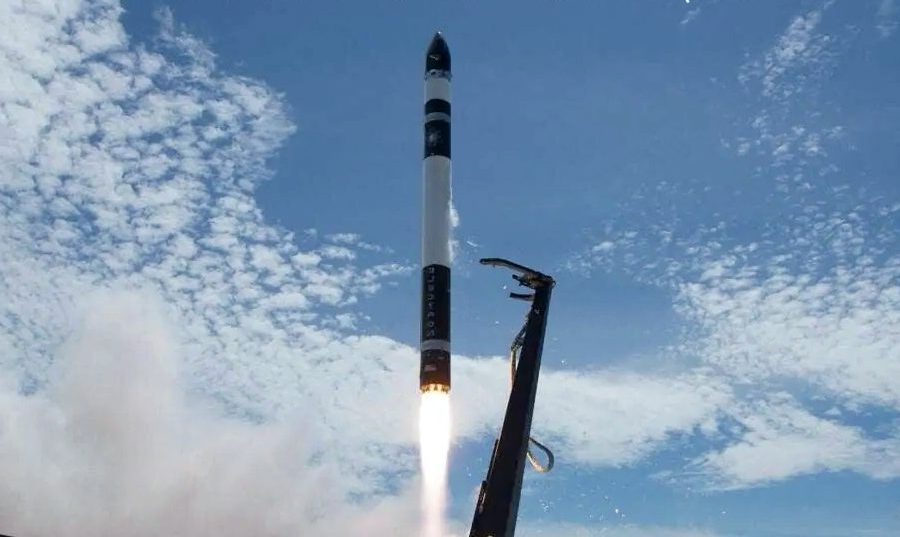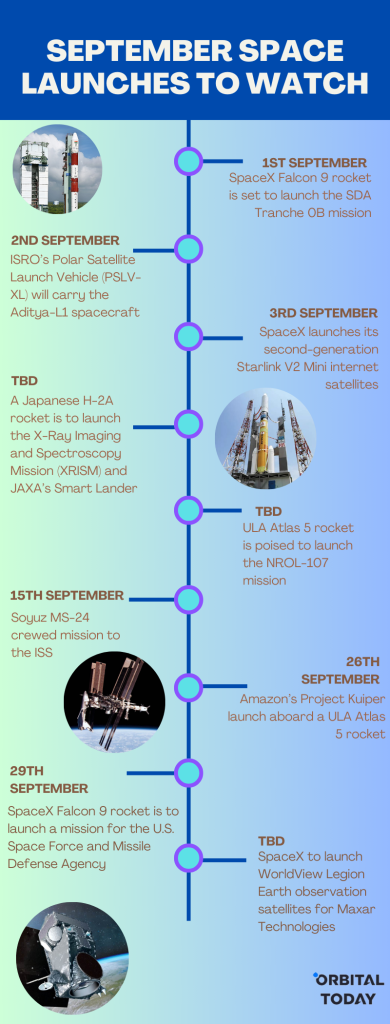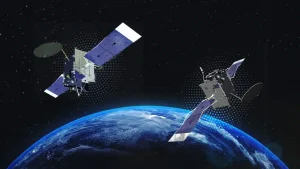September Space Launches: A Look at Upcoming Missions
1st Sep 2023
As the calendar turns to September, the world of space exploration is poised for an exciting month ahead with several notable launches scheduled. From military satellites to groundbreaking solar observation missions, the upcoming space launches in September promise to deliver new insights, technologies, and advancements in our understanding of the cosmos. Let’s take a closer look at some of the key September space launches on tap.

September 1: Falcon 9 – SDA Tranche 0B
On September 1st, at 8:25 a.m. PDT, a SpaceX Falcon 9 rocket is set to launch the SDA Tranche 0B mission from Space Launch Complex 4E at Vandenberg Space Force Base, California. This mission involves the deployment of 13 Tranche 0 demonstration satellites for the U.S. military’s Space Development Agency (SDA). These satellites will pave the way for a future constellation of military missile tracking and data relay satellites. Notably, this launch marks the second of two Falcon 9 missions designated to carry SDA demonstration spacecraft. The first stage booster of the Falcon 9 is expected to return to Landing Zone 4 at Vandenberg, adding to SpaceX’s impressive record of reusability. The launch was delayed from June and August 31 due to an engine issue on the Falcon 9 rocket.
September 2: PSLV-XL – Aditya-L1
The Indian Space Research Organization (ISRO) is gearing up for a significant milestone on 2nd September. At 11:50 a.m. IST, the Polar Satellite Launch Vehicle (PSLV-XL) will carry the Aditya-L1 spacecraft from the First Launch Pad at Satish Dhawan Space Centre in Sriharikota, India. This mission marks India’s first space-based endeavor to study the Sun. Aditya-L1 will be positioned in a halo orbit around the Lagrange point 1 (L1) of the Sun-Earth system, approximately 1.5 million km away. This unique vantage point will enable the spacecraft to conduct crucial observations of solar flares, space weather, and coronal heating.
September 3/4: Falcon 9 – Starlink 6-12
Continuing its efforts to expand global internet coverage, SpaceX is planning another launch of its second-generation Starlink V2 Mini internet satellites on 3rd or 4th September. The launch window is approximately from 7:07 to 11:37 p.m. EDT. The Falcon 9 rocket will take off from Launch Complex 39A at Kennedy Space Center, Florida. Following the launch, the first stage booster will execute a controlled landing on a drone ship stationed in the Atlantic Ocean. This ongoing initiative aims to provide high-speed, low-latency internet connectivity to underserved and remote regions around the world.
TBD: H-2A – XRISM & SLIM
A Japanese H-2A rocket, designated H-2A F47, is scheduled to launch the X-Ray Imaging and Spectroscopy Mission (XRISM) and JAXA’s Smart Lander for Investigating Moon (SLIM) mission. This joint project between the Japan Aerospace Exploration Agency (JAXA) and NASA focuses on high-resolution X-ray spectroscopic observations of hot gas plasma wind flowing through galaxies. XRISM’s observations will shed light on the composition and evolution of celestial objects. Additionally, the SLIM mission aims to test precision landing technology by heading to the Moon. This launch was delayed from the second quarter and further postponed from August 27 and 28.
TBD: Atlas 5 – NROL-107
A United Launch Alliance (ULA) Atlas 5 rocket is poised to launch the NROL-107 mission for the National Reconnaissance Office (NRO) in September. The classified payload, known as Silentbarker, is a collaborative effort between the NRO and the U.S. Space Force. While specific details about the payload remain undisclosed, the mission’s focus is on enhancing satellite threat intelligence and space situational awareness. The launch will take place from Space Launch Complex 41 at Cape Canaveral Space Force Station, Florida.
September 15: Soyuz MS-24
The Russian government’s Soyuz rocket is set to launch the Soyuz MS-24 spacecraft on 15th September. The crewed mission will transport Russian commander Oleg Kononenko, Russian flight engineer Nikolai Chub, and NASA astronaut Loral O’Hara to the International Space Station (ISS). The spacecraft will fly in the Soyuz-2.1a configuration, embarking on a long-duration stay aboard the ISS for the crew members.
September 26: Atlas 5 – Project Kuiper
In late September, Amazon’s Project Kuiper broadband constellation will see its first two demonstration satellites launched aboard a ULA Atlas 5 rocket. These satellites were originally slated to fly on the first Vulcan rocket. The launch is scheduled to take place from Space Launch Complex 41 at Cape Canaveral Space Force Station, Florida. This mission marks a significant step towards Amazon’s goal of providing global internet coverage through its satellite network.
September 29: Falcon 9 – USSF-124
On or around 29th September, a SpaceX Falcon 9 rocket is anticipated to launch a mission for the U.S. Space Force and Missile Defense Agency. While specific details about the mission remain undisclosed, this launch underscores the growing role of commercial spaceflight in supporting national security and defense initiatives.
TBD: Falcon 9 – WorldView Legion 1 & 2
SpaceX is preparing to launch the first pair of WorldView Legion Earth observation satellites for Maxar Technologies. These high-resolution remote sensing satellites are part of Maxar’s ambitious plan to deploy six satellites into various orbits. The launch of the Falcon 9 rocket will take place from Space Launch Complex 4E at Vandenberg Space Force Base, California, and the first stage of the rocket is expected to return to Landing Zone 4 at Vandenberg. This launch was previously delayed from April and June.
In conclusion, September is poised to be a month filled with diverse and compelling space launches, showcasing the collaboration between international space agencies and commercial entities. From studying the Sun and exploring celestial objects to enhancing satellite capabilities and expanding global internet coverage, these missions exemplify humanity’s relentless pursuit of knowledge and innovation in the final frontier. As each launch unfolds, the world will be reminded of the remarkable achievements and technological advancements that continue to shape our understanding of the universe.
![Beauty of the Pink Moon And Lyrid Meteor Shower in This Week’s Best Astrophotos [19-26 April] Beauty of the Pink Moon And Lyrid Meteor Shower in This Week’s Best Astrophotos [19-26 April]](https://orbitaltoday.com/wp-content/uploads/2024/04/Pink-Moon-is-on-its-way-above-the-mountains-1-300x300.jpg)




![Voyager 2 Loses Contact With NASA After Command Error [Updated] Voyager 2 Loses Contact With NASA After Command Error [Updated]](https://orbitaltoday.com/wp-content/uploads/2023/08/NASA-Voyager-the-Explorer-300x216.webp)
Thank you for your comment! It will be visible on the site after moderation.